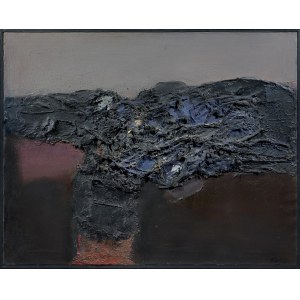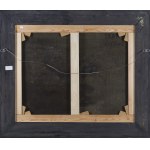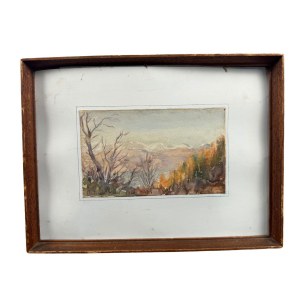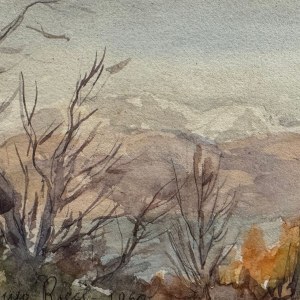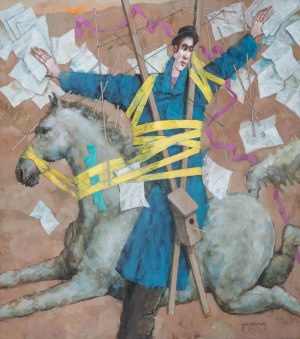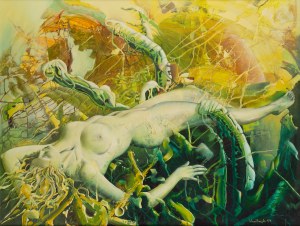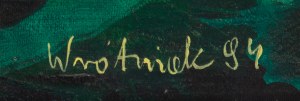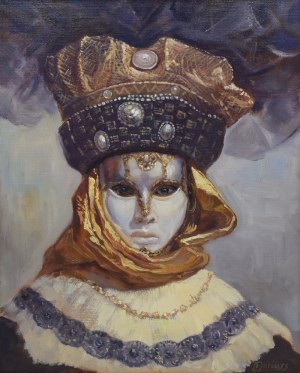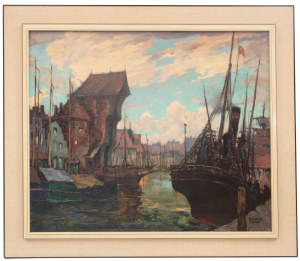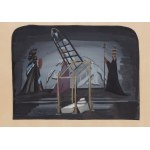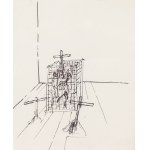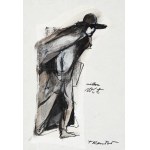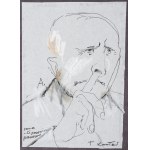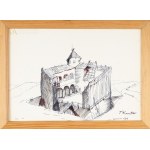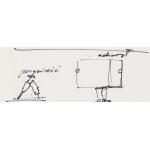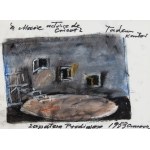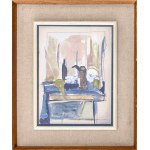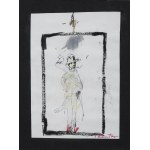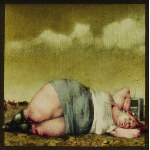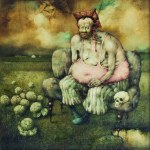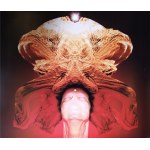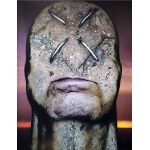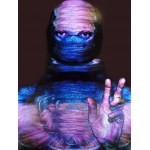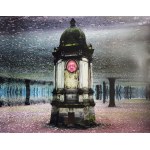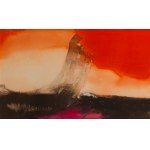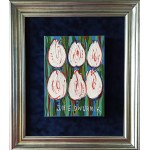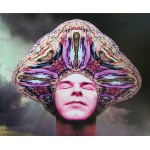80,0 x 100,0 cm - oil, collage, canvas signed p.d.: Kantor
signed on the reverse on canvas p.g. in black paint: T. KANTOR | V 1960,
signature repeated in orange paint: T. KANTOR | V 1960.
Tadeusz Kantor's first encounter with Tascist painting took place in Paris in 1955. When the artist returned to Poland, he became an ardent supporter of the new direction and began to paint his first Tascist paintings. In 1957, a text written by Kantor, titled Abstraction is dead - long live abstraction, appeared in Zycie Literackie, talking about the twilight of cold, geometric abstraction, and the birth of Tashism and Informel art, which brought hot, highly emotional, spontaneous painting. This was combined with an emphasis on the special importance of painting matter. Tadeusz Kantor wrote about the role of matter in the new painting as follows: Matter - element and vehemence, continuity and limitlessness, density and slowness, liquidity and capriciousness, lightness and ephemerality. Matter flared, exploding, fluorescing, summoned by light, dead and sedated. Clotting in which we discover all traces of life. Lacking all structure, only texture and consistency. (...) In this painting, the problem (content) is matter, as in geometric abstraction - geometry, and in surrealism - the world of dream visions. Cantor summarized the achievements of Tashism, stating that the painting has become an act of independent human creation. It stands not opposite nature, as its more or less slavish reflection, but next to it, or rather in the middle of it, it identifies with life itself, with man himself. (Tadeusz Kantor, Abstraction has died - long live abstraction, "Literary Life" No. 50, December 15, 1957, p. 6)
In 1959, Tadeusz Kantor gained a lot of publicity with his Tasist paintings at several important exhibitions: at the Galerie H. Legendre in Paris, at the Kunsthalle in Düsseldorf and at the Documenta in Kassel, and the works shown there are considered the apogee of this stage in the artist's oeuvre. Around 1960, in Western art, Tashism evolved towards structural abstraction, where the spontaneously formed matter of Tashism began to thicken into more stable, stagnant, less dynamic forms, already referred to as matter painting. Pieces of rags, old sheets of metal, plaster or tar paper, for example, were then incorporated into the matter of painting. When the first AICA congress was held in Poland in 1960, at an improvised show of paintings for foreign art critics at Krakow's Krzysztofory Gallery, Tadeusz Kantor presented relief-treated paintings that exposed the plastic structure of the material. As Lech Stangret wrote: Kantor's informel began to depart from Tasist rules over time. The painting matter thickened, taking the form of thick reliefs. The artist still retained the dripping technique in places, but combined it with the painterly gesture of spatula and brush. From the late 1950s, to increase the relief of the hardening mass, he used pieces of decayed wood, roots, covering them with black varnish or polyvinyl chloride. There were also paintings using epoxy resin, bags and rags soaked in carpenter's glue. (Lech Stangret, Tadeusz Kantor. Painterly ambalage of total work, Krakow 2006, p. 33)
The painting we present already bears the marks of these tendencies and the resulting transformations of the painterly form.
♣ A fee will be added to the auctioned price, in addition to other costs, resulting from the right of the artist and his heirs to receive remuneration in accordance with the Law of February 4, 1994 - on Copyright and Related Rights (droit de suite).
Tadeusz Kantor (Wielopole Skrzyńskie 1915 - Krakow 1990) studied stage design at the Academy of Fine Arts in Krakow from 1934 to 1939. In 1942 he founded the Underground Theater, which operated until 1944, giving two performances: "Balladine" and "Return of Odysseus." While working on the performances, a group of artists formed, who in 1945, under Kantor's leadership, formed the "Group of Young Artists." This in turn became the nucleus of both the experimental Cricot 2 Theater (created in 1955) and the second "Cracow Group" (created in 1957). In 1947 Kantor was on a one-year scholarship in Paris, and upon his return he was one of the organizers of the First Exhibition of Modern Art, Krakow 1948/49. In 1950-1954 he did not participate in exhibitions. Since 1955, his work ran on two tracks. On the one hand, he was active as a painter, creator of "ambalages" and, from 1965, happenings; on the other hand, he devoted himself to working on successive Cricot 2 performances, each of which was an artistic event, especially since the 1970s: "The Dead Class" (premiere 1975), "Wielopole, Wielopole" (1980), "Let the Artists Die" (1985), "I Will Never Return Here" (1988); he died after the last rehearsal of the performance "Today Is My Birthday" (premiere 1991). He collaborated constantly with galleries: Krzysztofory in Cracow (where Cricot 2 Theater was also based) and Foksal in Warsaw. Since 1979, he and the Cricot 2 theater stayed mainly in Florence. He was a theoretician of art and theater and the author of many manifestos. He participated in international exhibitions of the highest rank, such as Documenta in Kassel (1959, 1965), Venice Biennale (1960), Sao Paulo Biennale (1967). He received, among others, the Prix Rembrandt of the Goethe Foundation, Basel 1978, the Medal "Arts et Lettres" of the French Minister of Culture 1982, the Alfred Jurzykowski Foundation Prize, New York 1982 and many theater awards.
Recently viewed
Please log in to see lots list
Favourites
Please log in to see lots list



